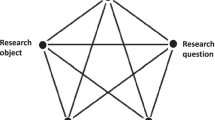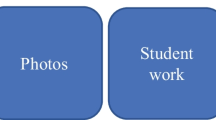Abstract
This chapter reports from a case study which focuses on the coordination of turn-taking within two small groups of kindergarten children (age 5–6) working on addition problems. The two segments of small group interaction were analysed from a multimodal, interpretative perspective. Drawing on Radford’s (J Res Math Educ, 2:7–44, 2013) theory of knowledge objectification, the study explores the characteristics of children’s turn-taking and what role children’s organisation of turn-taking plays in the movement of the joint activity, and thus for the materialisation of their mathematical thinking. The findings suggest that children’s various ways of organising turn-taking give rise to different ways in which their mathematical thinking is materialised and illustrates in particular how multiplicative structures emerge from their turn-taking. The chapter also illustrates how children’s turn-taking, and thus their mathematical thinking, seem dependent on contextual features like the formulation of the problem, available artefacts and children’s positional location in space. Implications that can be drawn from this study is that children’s early multiplicative thinking can be promoted by organising them in small groups and asking them to solve various equal groups addition problems with their hands and fingers.
Access this chapter
Tax calculation will be finalised at checkout
Purchases are for personal use only
Similar content being viewed by others
Notes
- 1.
‘Semantic structure’ refers to the way in which the problem is formulated, either in writing text or verbally, before the children start to solve it.
- 2.
The Agder Project is funded by the Research Council of Norway (NFR no. 237973), The Sørlandet Knowledge Foundation, The Development and Competence Fund of Aust Agder, Vest Agder County, Aust Agder County, University of Agder and University of Stavanger.
- 3.
A segment is here considered a self-contained part of a lesson with a distinct beginning and end.
- 4.
Transcription codes: (()) denotes non-verbal actions or contains explanations and interpretations necessary to understand the dialogue; _ denotes that the underlined word is emphasised; … denotes a pause in the verbal utterance; [] denotes that the utterance is cut off by another participant.
References
Anghileri, J. (1989). An investigation of young children’s understanding of multiplication. Educational Studies in Mathematics, 20(4), 367–385.
Baroody, A. J., & Purpura, D. J. (2017). Early number and operations: Whole numbers. In J. Cai (Ed.), Compendium for research in mathematics education (pp. 308–354). Reston, VA: National Council of Teachers of Mathematics.
Greer, B. (1992). Multiplication and division as models of situations. In D. Grouws (Ed.), Handbook of research on mathematics teaching and learning (pp. 276–296). New York: Macmillan.
Lerner, G. H. (2003). Selecting next speaker: The context-sensitive operation of a context-free organization. Language in Society, 32(2), 177–201.
Lu, L., & Richardson, K. (2018). Understanding children’s reasoning in multiplication problem-solving. Investigations in Mathematics Learning, 10(4), 240–250.
Mondada, L. (2007). Multimodal resources for turn-taking: Pointing and the emergence of possible next speakers. Discourse Studies, 9(2), 194–225.
Mulligan, J. T., & Mitchelmore, M. C. (1997). Young children’s intuitive models of multiplication and division. Journal for Research in Mathematics Education, 28(3), 309–330.
Mulligan, J. T., & Mitchelmore, M. C. (2013). Early awareness of mathematical pattern and structure. In L. D. English & J. T. Mulligan (Eds.), Reconceptualizing early mathematics learning (pp. 29–45). New York: Springer.
Radford, L. (2010). Layers of generality and types of generalization in pattern activities. PNA, 4(2), 37–62.
Radford, L. (2013). Three key concepts of the theory of objectification: Knowledge, knowing, and learning. Journal of Research in Mathematics Education, 2(1), 7–44.
Radford, L. (2015). Rhythm as an integral part of mathematical thinking. In M. Bockarova, M. Danesi, D. Martinovic, & R. Núñez (Eds.), Mind in mathematics: Essays on mathematical cognition and mathematical method (pp. 68–85). München, Germany: LINCOM GmbH.
Radford, L., & Roth, W.-M. (2011). Intercorporeality and ethical commitment: An activity perspective on classroom interaction. Educational Studies in Mathematics, 77(2-3), 227–245.
Roth, W.-M., & Radford, L. (2011). A cultural-historical perspective on mathematics teaching and learning. Rotterdam, The Netherlands: Sense.
Sacks, H., Schlegoff, I., & Jefferson, G. (1974). A simplest systematics for the organization of turn-taking in conversation. Language, 50(4), 696–735.
Author information
Authors and Affiliations
Corresponding author
Editor information
Editors and Affiliations
Rights and permissions
Copyright information
© 2020 Springer Nature Switzerland AG
About this chapter
Cite this chapter
Breive, S. (2020). The Materialisation of Children’s Mathematical Thinking Through Organisation of Turn-Taking in Small Group Interactions in Kindergarten. In: Carlsen, M., Erfjord, I., Hundeland, P.S. (eds) Mathematics Education in the Early Years. Springer, Cham. https://doi.org/10.1007/978-3-030-34776-5_17
Download citation
DOI: https://doi.org/10.1007/978-3-030-34776-5_17
Published:
Publisher Name: Springer, Cham
Print ISBN: 978-3-030-34775-8
Online ISBN: 978-3-030-34776-5
eBook Packages: EducationEducation (R0)




